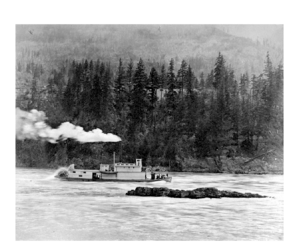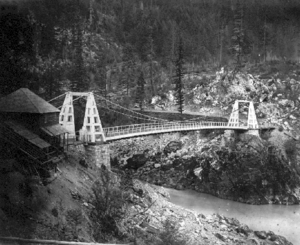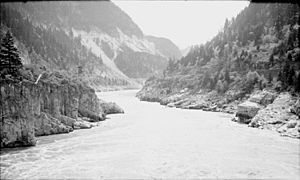Skuzzy (sternwheeler) facts for kids

The Skuzzy on the Fraser River near Yale, British Columbia, 1883
|
|
Quick facts for kids History |
|
|---|---|
| Name | Skuzzy |
| Laid down | 1882 at Spuzzum |
| Launched | May 4, 1882 at Spuzzum |
| In service | May 4, 1882 |
| Out of service | circa. 1884 |
| Notes | Captain Ausbury Insley and SR Smith |
| General characteristics | |
The Skuzzy was a special type of boat called a sternwheeler. It was built in 1882 for the Canadian Pacific Railway (CPR) by a contractor named Andrew Onderdonk. The Skuzzy became famous for being the first sternwheeler to travel through the dangerous rapids of the Fraser River Canyon, north of Yale.
Building the Skuzzy
Andrew Onderdonk was in charge of building a tough section of the railway. This part stretched about 29.5 miles (47.5 km) from Boston Bar to Lytton. Moving railway supplies by land was very slow and costly. It involved using pack trains, which are groups of animals carrying goods.
Onderdonk realized that using a boat on the Fraser River would be much faster and cheaper. He decided to build the Skuzzy to transport materials. This would save him a lot of money on road tolls. The Skuzzy was built in 1882 at a place called Spuzzum.
The Fraser River in the canyon is known for its powerful currents and whirlpools. One of the most challenging parts is a narrow section called Hell's Gate. To get through these waters, the Skuzzy would need a very skilled captain.
On May 17, 1882, Captain Ausbury Insley tried to pilot the Skuzzy upstream. He successfully guided the boat through some rapids. He even passed under the Alexandra Bridge, which was built in 1863. However, when he reached the entrance of Hell's Gate Canyon, he could not go further. The river was at its highest level in 40 years, making passage impossible.
Conquering Hell's Gate
Andrew Onderdonk was determined to get the Skuzzy through. He brought in a new captain and engineer from Oregon. On September 7, they tried again to pass through Hell's Gate. But once more, the Skuzzy failed to make it.
Onderdonk then came up with a clever plan. He had strong metal rings, called ringbolts, drilled into the canyon walls. He also gathered 125 Chinese railway workers. These workers would help pull the boat. People watching were betting against the Skuzzy succeeding. The odds were 100 to 1 that it would fail.
Finally, with a combination of power and teamwork, the Skuzzy made it. The boat used its steam-powered capstan to winch itself forward using a cable. At the same time, the 125 men pulled on a tow rope. It took an incredible 16 days to travel just 16 miles (26 km) to Boston Bar. The Skuzzy became the first sternwheeler to successfully reach Lytton. This achievement greatly helped in building the Canadian Pacific Railway.



